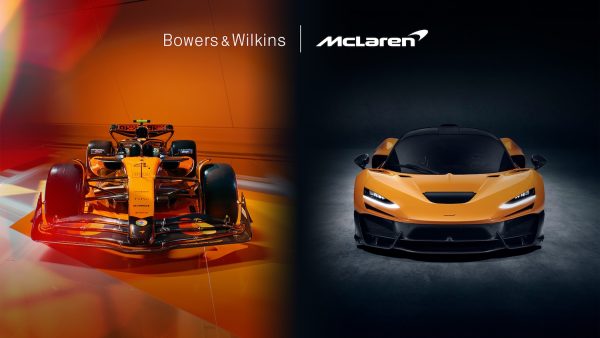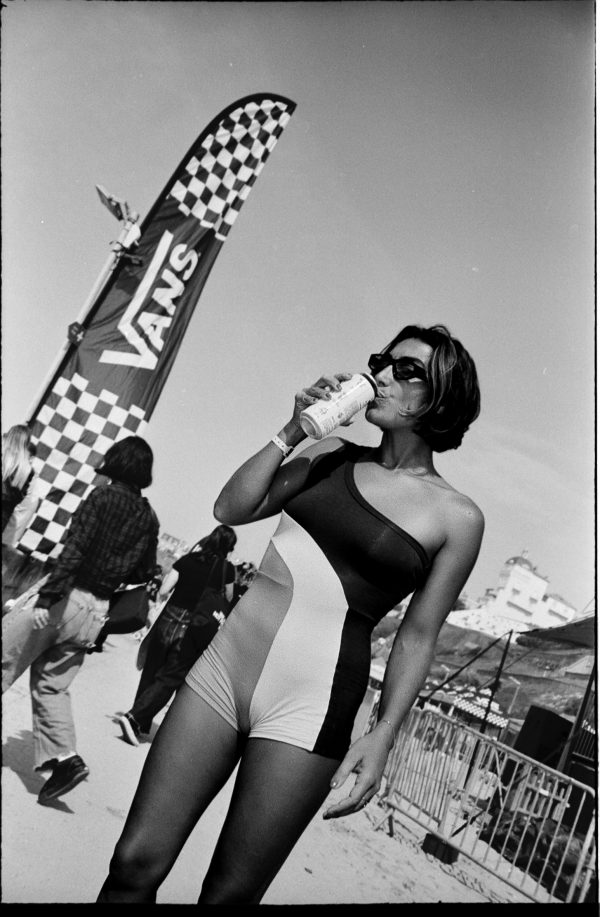
The moon hangs atop the corner of a long, upscaled photograph of a gas station set in what appears to be the rural USA. A vibrant Coca-Cola sign calls out in the middle of the scene as though it was a natural occurrence set in an artificial habitat. All elements in the composition are frozen in time, at peace with one another and crystalised in the godly luminescence of the sky’s twilight. This is a description of one of the many eerily captivating scenes from the latest William Eggleston retrospective, which opened at C/O Berlin and is on view until May 4th, 2023.
The exhibition is joined by two other brilliant showcases from Katarina Wojtas and Anastasia Samoylova. It completes the puzzle of pioneering American colour photographers to show at the Berlin institution and is titled Mystery of the Ordinary. It presents a timeline of Eggleston’s works from his beginnings in black & white, a revisit of images taken around the time of his first-ever MoMA show in 1976, and his travels around Berlin in the ‘80s: an important note regarding colour photography’s journey to recognition in Europe’s art world. Even with the additional context surrounding a selection of the photographs on display, they remain an unsolvable riddle and the weight of their allure only becomes denser.


There is photography before William Eggleston and after him. While the southern dandy was certainly not the only photographer of an artistic ambition to be shooting in colour, he was the first to premiere a solo exhibition at the MoMA – a monumental moment for a style of photography that was largely dismissed at the time. Like most pioneering art, many critics ridiculed Eggleston’s show in 1976, before recognising its value and issuing their apologies. But what’s so mystical about his photographs goes beyond their vibrant colours alone and into a peculiar way of looking at the world around oneself. It’s what Eggleston refers to as Democratic photography and it is to hold all subjects in an equal hierarchy, with not one subject more or less important than another. Captured in this latest retrospective, his vision is just as captivating in the original photographs from his debut show in ‘76 as in The Outlands – selected outtakes from a pool of 5,000 images captured between ‘70 and ‘73 and newly on display.
Eggleston, a native of Memphis, born in 1939 (he is now 83 years old) accredits his interest in pursuing photography to Henri-Cartier Bresson, whose work he’d discovered in a book that belonged to a friend. This retrospective kicks off with a room of the black & white images Eggleston began taking at the end of the ‘50s before his shift to colour. In them, we already see the work of a skilled photographer, creating expert compositions and depicting the influence of Bresson’s The Decisive Moment – the art of capturing the fleeting moment when everything in a composition naturally falls into balance. Seeing these early images – like an ominous close-up staring into an empty oven, or a ceiling fan, stagnant and hovering above like a UFO – shows that he was already experimenting with a radical point of view. These images serve as predecessors to more widely known colour works by Eggleston that were soon to follow.

The main highlight of this show is the unveiling of previously unseen images from The Outlands, displaying photographs that recall some of the classics from Eggleston’s oeuvre. Such as the picture of an oxygen tank, ominously floating in the corner of a red room with the word “God” written on the wall next to it. Fans will recognize this red room as the same one from Eggleston’s famous photograph of the red ceiling (featured on a Big Star album cover) and in one of the naked man, which can be seen in the second room of the retrospective. Another example might be the image of a tricycle featured on the cover of William Eggleston’s Guide. New on display, is an image of a blue car shot in landscape view with the camera placed on the ground: expertly layering the road, car and sky, at the same location as the iconic image adorning his book’s cover.
What’s seen in the image of the car, softly, is a sticker on the automobile’s rear window inscribed “REGISTER COMMUNISTS NOT OUR FIREARMS”. Though this is only another piece of the image, in which everything is held in equal measure; it’s the kind of jarring detail that transports viewers to the American south during a time of rising political tensions in the ‘70s. It’s another aspect of Eggleston’s photography which makes his work resonate more relevant than ever, as it documents the prevalence in which politics and capitalism were already an inescapable part of daily American life. Not that Eggleston was commenting on these subjects in any way, but it’s that very reason which makes these aspects come across so prevalent.


Take the relentless presence of Coca-Cola ads and their unmistakable red hue. A recurring subject in the photographer’s catalogue, not because I assume he loved soda (from what I hear he fancies bourbon) but because the ads popped and were simply everywhere. Today, we still find ads inescapable and if anything they’ve become slyer in how they force themselves upon us. Or, in the striking image of a Black woman peering over her shoulder, gazing into the camera with eyes of desperation while at the funeral of a local blues musician. Although the image oozes an aged patina, it resonates as strikingly apropos to the Tyre Nichols protests happening in Memphis, which began only a day after this exhibition’s opening. See the decaying structures found in a number of his images: like rusted automobiles, desolate bars, or a dishevelled drive-in cinema looking post-apocalyptic in its emptiness. These days, it’s not the drive-ins disappearing but cinemas and theatrical productions as a whole. Eggleston’s photographs capture the remnants of a time that feels simultaneously distant and present; in one adjective, they’re timeless.
All three exhibitions on display in the space are brilliant in their own way and interestingly complement one another when juxtaposed. Abzgram, by Karolina Wojtas, the youngest of the 3 photographers and winner of the C/O Berlin Talent Award 2022, disregards the rules of photography and its form. And while being unsecretive in its overall subject matter, the exhibition is surreal in its content. As guests enter the hall, they’ll feel as though they’re walking into someplace haunted, thanks to the rustic fence Karolina transported from a now-defunct Polish school to the show space. Visitors will soon find themselves stepping into the artist’s mind and her reflections on the horrors of a broken school system’s militarism.
In a frenzied, punk-rock spirited youthfulness which brilliantly contains just as much finesse as it doesn’t, Wojtas’ images and the feelings they inhabit expand into three typically found settings within a Polish public school: the classroom to learn, a playroom for recess (or gym), and the auditorium to graduate. Her dreamy yet nightmarish photographs capture the students and the interiors of their schools, serving as building blocks (literally) into a world of playfulness, danger and destruction.


On the other hand, Anastasia Samoylova’s latest exhibition Floridas (and first institutional solo showcase in Germany) is subtler concerning its subject matter but full of terror beneath its beautiful pastels and shapely reflections. It captures the dualities present in American life, not unlike those found in the works of David Lynch, and in this case specific to the state of Florida. What kicks off as a room of pink Florida sunshine is offset by the following room which depicts the same state, but pulls back the curtains on its true essence: a dreary, dwindling swampland containing a multitude of appearances and contradictions. Such as the fluorescent green wall of an arms dealership with rifles painted on; or the belly of a White Florida man tatted up with dual handguns and a confederate flag; curated next to an upscaled image of a Black Floridian protesting the police brutality of their people.
Suddenly, the room full of pink sunshine doesn’t resonate so brightly. Visitors may benefit by re-examining the opening images and the facades behind their tumblr-esque colours. It’s intriguing to see the many layers of the country’s most geographically southern state, picked apart through the eyes of Samoylova, a foreigner living in the United States who was originally born in the USSR and has been based in Miami since 2016. She has described Florida as a “flattening” of the United States all-together, which speaks to the flatness of her photography and prior work in collages.
The majority of the photographs were taken around 2020, a tumultuous period in US history that left the country in a vulnerable state as a result of the death of George Floyd, the Covid-19 Pandemic and a divisive presidential election. For many, it is a time associated with anxiety and Samoylova is no exception. She expressed at the press viewing that she’d already experienced a loss of democracy in her homeland and was fearful of losing it again, this time in her new home. The photographs display the complexities of humanity via the novelty of going on a road trip with a camera. As Samoylova mends her anxieties on this journey, we see a place that has attempted to mend its own, through the tricks of tourism and marketing.
To tie it back to William Eggleston: the three exhibitions, singular in the eyes of the photographers, each reveal the hidden truths of a particular world, warts and all. From one display which is clear in its subject, to another that is slightly more obscure, and a final one that is a complete mystery – a mystery of the ordinary. But what’s ordinary, only appears ordinary when we look but don’t see. When questioned why he only photographs in colour, Eggleston has said “The way I have always looked at it is the world is in color. And there’s nothing we can do about that…” In Eggleston’s snapshot-like pictures that resonate like masterful paintings (or little paintings as he’s called them,) he captures the space between and around his subjects. He has described his approach as being like a fly, buzzing around at all angles – but the photographs themselves appear as though a ghost might’ve taken them. He only photographs his subjects once – sagely in his restraint, we can learn a lot from his ways of seeing, not only applying them to photography, but to life itself.

C/O Berlin presents the retrospective William Eggleston: Mystery of the Ordinary from January 28 to May 4, 2023, in addition to Anastasia Samoylova and Karolina Wojtas presentations.
words. Lucas Pantoja


Schön! Magazine is now available in print at Amazon,
as ebook download + on any mobile device





























































































